Parshas Terumah ushers in the subject that is the basic running theme for the remainder of Sefer Shemos: namely, the construction of the Mishkan and all of its accoutrements. It would be somewhat of a shame for one to remain with just a superficial picture of this otherwise massive topic. Such a picture he may have acquired from childhood, a time when the rich and profound meanings were beyond his grasp. In truth, of course – as is clear from the many commentators – the Mishkan and all of its elements are replete with deep meanings and allusions, contained within every last detail of every implement and aspect of the Mikdash and its service. And even for “us grown-ups,” the true depth of meaning behind it all is largely beyond our comprehension, as it involves the loftiest and most elevated Kabbalistic secrets.
Bearing all of this in mind, we will focus, by way of example, on a particular aspect from this wondrous and considerable topic; even in this area we will barely scratch the surface. Thus, we attempt to present one approach to one characteristic of one of the Temple implements – and to derive at least one lesson thereby.
Beautifying the Menorah
As candelabras go, the Menorah was a fairly elaborate item. As the passuk describes, all of its various features were formed from a single entity: וְעָשִֹיתָ מְנֹרַת זָהָב טָהוֹר מִקְשָׁה תֵּיעָשֶֹה הַמְּנוֹרָה יְרֵכָהּ וְקָנָהּ גְּבִיעֶיהָ כַּפְתֹּרֶיהָ וּפְרָחֶיהָ מִמֶּנָּה יִהְיוּ – “And you shall make a Menorah of pure gold; the Menorah (and all of its components) shall be beaten out (from one piece): its base, stem, goblets, knobs, and flowers shall (emanate) from it” (Shemos 25:31).
The Kesav Sofer provides some insight into the meaning behind these decorative accessories. The overall Menorah, as is well known, is emblematic of the Torah, as intimated by the passuk, כִּי נֵר מִצְוָה וְתוֹרָה אוֹר – “For a mitzvah is a candle, and Torah is light” (Mishlei 6:23). The ornaments that added to the Menorah’s beauty, explains the Kesav Sofer, are representative of middos tovos (positive character traits), which “beautify” a person and further his acceptability in the eyes of his fellows. In other words, while Torah is paramount, a person must also display traits of pleasantness, a point driven home by the Mishnah in Avos (3:10):
כֹּל שֶׁרוּחַ הַבְּרִיּוֹת נוֹחָה הֵימֶנּוּ, רוּחַ הַמָּקוֹם נוֹחָה הֵימֶנּוּ. וְכֹל שֶׁאֵין רוּחַ הַבְּרִיּוֹת נוֹחָה הֵימֶנּוּ, אֵין רוּחַ הַמָּקוֹם נוֹחָה הֵימֶנּוּ.
“Anyone with whom people are pleased – Hashem is also pleased (with that person). And anyone with whom people are displeased – Hashem is also displeased (with him).”
However, there is an important caveat attached to this principle. A person learning of this notion might draw an erroneous conclusion. It is not enough to study Torah, he might think. To develop proper traits and round out my character, I must examine other areas of wisdom. From them I will learn and cultivate proper morals and decorum. This position is refuted by the Menorah’s construction, as conveyed by the passuk. As stated, the decorative elements of the Menorah allude to a person’s middos; but they are one with the Menorah, which itself is the symbol of Torah. The ornamental flowers and goblets are fashioned from the same metallic entity and emanate from the Menorah itself. We see, then, that one’s moral attitudes and proper traits are to be derived from the Torah itself, without venturing into foreign fields (cf. Kesav Sofer, Shemos 25:11).
Same Action – Different Results
A similar idea manifests itself in the narrative involving the sons of No’ach. The Torah recounts the episode whereby No’ach, having become inebriated, ended up uncovered within his tent. The matter was disclosed by his son Cham in a most inappropriate manner; but his other sons, Shem and Yefes, hastened to restore their father’s dignity: וַיִּקַּח שֵׁם וָיֶפֶת אֶת־הַשִּׂמְלָה וַיָּשִֹימוּ עַל־שְׁכֶם שְׁנֵיהֶם וַיֵּלְכוּ אֲחֹרַנִּית וַיְכַסּוּ אֵת עֶרְוַת אֲבִיהֶם – “And Shem and Yefes took the garment and placed it on both of their shoulders; they walked backward, and covered their father’s exposure” (Bereishis 9:23). Rashi takes note of the fact that, while both Shem and Yefes were involved in this meritorious act, the verse speaks in the singular form: “Vayikach” – literally: “And he took.” Rashi explains in the name of Chazal that the intimation is that one of the brothers – Shem – actually “exerted himself more” in performing this mitzvah. They were both rewarded, but Shem’s reward was greater.
At first glance, this is a very puzzling notion. They both took hold of the garment. They both covered their father in a respectful way. Yet Shem’s participation is granted extra weight. From the outside, at least, it seems as if both brothers did the exact same thing. In what way did Shem’s deed surpass that of Yefes? Did he hold the garment tighter?
While the actions were the same, it would seem that the prime distinction was in the intent. Yefes covered his father due to his own moral convictions; in his eyes, it was only right and decent to preserve his father’s dignity. But Shem’s deed was even more elevated, for he performed the deed with the intention of fulfilling the command of Hashem (based on Ohr Gedalyahu [R’ Gedalyah Shorr], Chanukah, p. 58).
From the above we can understand that middos and morality have true value only insofar as they emanate from the Torah. Indeed, there are unfortunately numerous examples whereby morals and decency that were not connected to Torah did not endure for long. One need only look back, as an example, to the tragic events of the Twentieth Century. R’ Avigdor Miller would point to travel literature written shortly before 1940, lauding the German and Austrian people for their legendary “gemutlichkeit” (kindliness). We know only too well, he concludes, where such “gemutlichkeit” led (Awake My Glory, p. 120).







